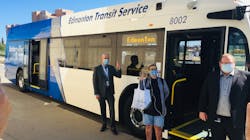First battery-electric bus deployed on Edmonton Transit Service
Officials from the city of Edmonton, AB, Canada, Edmonton Transit Service (ETS) and Proterra celebrated the deployment of ETS’ first battery-electric bus into service on Aug. 4.
The electric buses were introduced in late July and the start of service by the 40-foot battery-electric bus was called a historic milestone; there are several reasons why:
- ETS has received 21 of 40 electric buses, which represents one of the largest Canadian orders for electric buses;
- The buses will use in-depot overhead infrastructure to charge, which is a first for North America; and
- The buses themselves, manufactured by Proterra, each contain 660 kWh of onboard energy - the most energy storage on any 40-foot electric bus - and have a range of 350 km (217.47 miles) per charge.
“Electric buses are a major component of the future of public transit in our city and across Canada because they save the city money and benefit not only transit users who get to experience the perks of a quieter commute with decreased emissions, but also Edmontonians who aren't regular commuters on our transit system, as they also benefit from the city meeting its energy and climate goals,” said Edmonton Mayor Don Iveson.
Electric buses will be able to operate on almost every ETS route and all buses come equipped with protective operator shields. In 2015, ETS winter tested several electric buses to ensure the technology would be suitable for Edmonton’s cold weather, steep river valleys and broad geographic transit area.
Jack Allen, CEO of Proterra, called the launch of the ETS’ battery-electric bus service “one of the most impressive end-to-end deployments” the company has seen in North America.
“The ETS deployment showcases how to successfully implement an electric-bus fleet and charging infrastructure for current fleet needs, as well as plan for expansion in the near future,” said Allen.
The remaining 19 electric buses will arrive this fall and all will be housed at the new Kathleen Andrews Transit Garage and Centennial Garage, with the Kathleen Andrews Transit Garage set to become the electric bus hub once charging infrastructure is fully online. ETS explains utilizing overhead chargers inside transit facilities reduces the amount of floor space required for charging.
“From the start, we’ve been very intentional about how we’ve designed our electric bus program,” said Ryan Birch, director of Transit Operations, ETS. “We’ve taken a unique approach to charging our buses inside transit facilities. This provides important redundancy that makes our electric bus fleet more reliable for transit customers and will help us continue to modernize our transit system.”
About the Author

Mischa Wanek-Libman
Group Editorial Director
Mischa Wanek-Libman is director of communications with Transdev North America. She has more than 20 years of experience working in the transportation industry covering construction projects, engineering challenges, transit and rail operations and best practices.
Wanek-Libman has held top editorial positions at freight rail and public transportation business-to-business publications including as editor-in-chief and editorial director of Mass Transit from 2018-2024. She has been recognized for editorial excellence through her individual work, as well as for collaborative content.
She is an active member of the American Public Transportation Association's Marketing and Communications Committee and served 14 years as a Board Observer on the National Railroad Construction and Maintenance Association (NRC) Board of Directors.
She is a graduate of Drake University in Des Moines, Iowa, where she earned a Bachelor of Arts degree in Journalism and Mass Communication.
